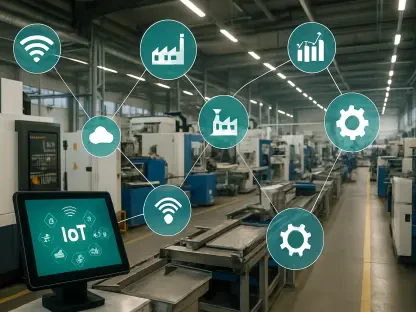In a world increasingly driven by artificial intelligence (AI), the limitations of traditional computing systems are becoming glaringly apparent, with skyrocketing energy demands and sluggish data processing threatening to stall technological progress. Enter neuromorphic computing, a revolutionary approach that draws inspiration from the human brain to create chips capable of mimicking neural networks with astonishing efficiency and adaptability. This brain-inspired technology promises to shatter the barriers of conventional hardware by integrating memory and processing in ways that echo the brain’s natural structure. Unlike standard processors that guzzle power and struggle with real-time demands, neuromorphic systems offer a tantalizing glimpse into a future where machines learn and react with human-like intuition. This article explores the transformative potential of this cutting-edge field, delving into its unique mechanisms, wide-ranging applications, competitive market dynamics, societal implications, and the challenges that lie ahead. As industries from autonomous vehicles to healthcare stand poised to be reshaped, understanding this technology is no longer optional but essential for grasping the next wave of digital innovation.
Unpacking the Core of Brain-Inspired Technology
At the heart of neuromorphic computing lies a fundamental shift from traditional architectures that have long dominated the tech landscape. Conventional systems, built on the von Neumann model, separate memory and processing units, leading to constant data shuffling that creates delays and burns excessive energy. Neuromorphic chips, by contrast, integrate these functions within artificial neurons and synapses, mirroring the brain’s seamless operation. This design eliminates bottlenecks, enabling faster computation with significantly less power. Such efficiency is critical as AI applications grow more complex, demanding hardware that can keep pace without draining resources. The result is a system ideally suited for tasks requiring rapid adaptability, positioning this technology as a cornerstone for future advancements in machine learning and beyond.
Another defining trait of neuromorphic systems is their reliance on Spiking Neural Networks (SNNs), which replicate the brain’s event-driven processing. Unlike traditional processors that run continuously and consume power regardless of workload, SNNs activate only when triggered by specific inputs, sending electrical “spikes” to handle data. This selective operation slashes energy use, offering a sustainable alternative at a time when data centers and AI models are under scrutiny for their environmental footprint. The ability to process information only when necessary also enhances speed, making these systems a powerful fit for real-time applications. As the digital world grapples with escalating energy costs, this brain-inspired approach stands out as a beacon of efficiency and innovation.
Real-World Impacts Across Diverse Sectors
The potential applications of neuromorphic computing stretch across a variety of industries, each poised to benefit from its unique capabilities. In the realm of autonomous vehicles, these chips excel at processing vast amounts of sensory data in real time, enabling split-second decisions that are vital for safety and performance. Whether it’s detecting obstacles or navigating complex environments, the technology mimics human-like reflexes, ensuring quicker and more reliable responses than traditional systems can muster. This capacity to handle dynamic, unpredictable scenarios could redefine transportation, making self-driving cars not just a novelty but a mainstream reality with enhanced dependability. The implications for reducing accidents and optimizing traffic flow are profound, marking a significant leap forward for the automotive sector.
Beyond transportation, healthcare is another field ripe for transformation through neuromorphic technology. Imagine wearable devices or intelligent prosthetics powered by chips that adapt to a patient’s specific needs with precision, learning and adjusting in real time. Such advancements could revolutionize personalized care, offering tailored solutions for monitoring vital signs or aiding mobility. Additionally, the technology dovetails with trends like Edge AI and the Internet of Things (IoT), allowing devices to process data locally rather than relying on cloud connectivity. This shift minimizes latency, conserves bandwidth, and strengthens data privacy—an essential consideration in medical contexts. By embedding intelligence directly into devices, neuromorphic computing paves the way for a smarter, more responsive healthcare ecosystem.
Competitive Forces Shaping the Market
The neuromorphic computing arena is witnessing a fierce race among industry leaders and emerging players, all eager to stake their claim in this transformative space. Tech giants like Intel, with its pioneering Loihi chips, and IBM, with innovations such as NorthPole, are channeling significant resources into developing brain-inspired hardware that prioritizes energy efficiency and speed. These companies are setting benchmarks for what’s possible, pushing the boundaries of AI performance with systems designed for real-time learning. Their involvement signals a broader industry shift, where traditional semiconductor approaches are being reevaluated in favor of adaptive, low-power solutions. As they forge ahead, their efforts are reshaping expectations for what computing hardware can achieve in an AI-driven era.
Meanwhile, smaller innovators and startups like BrainChip and SynSense are making waves with specialized offerings tailored for niche applications, particularly in low-power edge computing. These agile contenders are proving that size isn’t everything, as they carve out vital roles in a market hungry for efficient alternatives. The competitive dynamics underscore a critical trend: energy efficiency and adaptability are becoming the new gold standards for technological success. Companies that fail to pivot toward neuromorphic solutions risk obsolescence as industries prioritize sustainable, responsive systems over outdated, power-intensive models. This race isn’t just about innovation—it’s about redefining the future of computing itself, with winners likely to dominate the next generation of AI technologies.
Navigating Societal and Ethical Dimensions
As neuromorphic computing integrates into critical sectors like transportation and healthcare, its broader societal impacts come into sharp focus. One promising area is cybersecurity, where the technology’s ability to detect unusual patterns in real time offers a robust defense against emerging threats. By processing data with brain-like speed and intuition, these systems can identify anomalies that might signal a breach, providing a proactive shield in an increasingly digital world. This capability could bolster trust in connected systems, from smart cities to personal devices, ensuring that security keeps pace with technological growth. The potential to safeguard sensitive information in an era of rampant cyber risks is a compelling advantage that cannot be overlooked.
Yet, with great power comes significant responsibility, and neuromorphic technology raises pressing ethical concerns that demand attention. As these systems become embedded in autonomous decision-making—whether in vehicles or medical devices—issues of data privacy and algorithmic bias loom large. How can society ensure that such powerful tools operate transparently and fairly, without perpetuating harm or eroding trust? The deployment of brain-inspired systems also necessitates accountability, particularly when errors could have life-altering consequences. Strong regulatory frameworks must evolve alongside the technology to address safety and ethical dilemmas, ensuring that innovation doesn’t outstrip oversight. Balancing progress with responsibility will be a defining challenge as adoption accelerates.
Charting the Path Forward for Innovation
Looking ahead, neuromorphic computing remains in its formative stages, with substantial room for growth and refinement. Short-term efforts are centered on enhancing chip designs, increasing the density of artificial neurons to boost processing power, and optimizing algorithms for Spiking Neural Networks. These advancements aim to make the technology more robust and versatile, capable of handling even more complex AI tasks with minimal energy. Success in these areas will be crucial for bridging the gap between experimental research and practical, scalable solutions. As developers tackle these technical hurdles, the focus is on laying a foundation that can support broader commercial applications in the near future.
Long-term, the vision for neuromorphic computing hinges on affordability and accessibility, ensuring that the technology isn’t confined to elite research labs or deep-pocketed corporations. Standardizing programming models and creating developer-friendly tools will be essential to democratize access, fostering an ecosystem where innovation thrives across diverse sectors. Key areas to monitor include autonomous systems and personalized healthcare, where breakthroughs could catalyze widespread adoption and transform everyday experiences. Investors and stakeholders should also track complementary advancements in software and services, as these will amplify the technology’s reach beyond hardware alone. The journey ahead promises to build a digital landscape that’s not only smarter but also more attuned to the organic adaptability of human cognition.
Reflecting on a Transformative Legacy
Looking back, neuromorphic computing emerged as a bold response to the inefficiencies that plagued traditional systems, delivering brain-inspired solutions that prioritized energy efficiency and real-time adaptability. Its journey showcased remarkable strides in overcoming hardware limitations, with Spiking Neural Networks and integrated designs redefining what machines could achieve. Applications in autonomous vehicles, healthcare, and IoT demonstrated tangible benefits, while fierce market competition among tech giants and startups alike underscored the technology’s strategic importance. Ethical and societal challenges, from privacy concerns to regulatory needs, added depth to the discourse, highlighting the necessity of balanced progress.
Moving forward, the focus should shift to actionable steps that ensure this technology’s potential is fully realized. Prioritizing research into scalable, cost-effective solutions will be vital, as will fostering collaborations between industry, academia, and policymakers to address ethical concerns. Building a robust ecosystem of tools and talent can accelerate integration into mainstream applications, from smarter edge devices to groundbreaking medical innovations. As the digital world continues to evolve, staying attuned to emerging trends and breakthroughs in this field will be essential for shaping a future where technology mirrors the ingenuity of the human mind.









